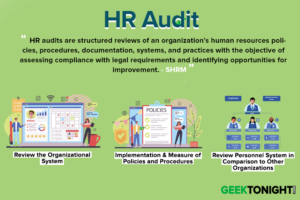What is Performance Management?
Performance management is a system designed to identify the ways to achieve organizational goals through constant assessment and feedback leading to improvement of employee performance.
Unlike the performance appraisal process, performance management is an ongoing assessment of employees in a manner geared to match their goals to the organizational goals and it also makes strong use of goal-setting and metrics to identify progress and areas of individual strengths.
Table of Content
- 1 What is Performance Management?
- 2 What is Performance?
- 3 Concept of Performance Management
- 4 Characteristics of Performance Management
- 5 Objectives of Performance Management
- 6 Principles of Performance Management
- 7 Challenges to Performance Management
- 8 Performance Appraisal to Performance Management
- 9 Human Resources Tutorial
- 10 Human Resource Management
The basic goal of performance management is to promote and improve employee effectiveness in every perspective.
The power of any organization is increasingly linked to its intellectual capital rather than its physical assets because the people in organizations are now the drivers of corporate performance and competitiveness.
Therefore, it deals with improving organizational performance by improving employee performance and essentially, the cost of competitiveness involves efficiency and productivity.
What is Performance?
“Performance is behavior and should be distinguished from the outcomes because they can be contaminated by systems factors”.
Concept of Performance Management
Performance management is a continuous process where managers and employees work together to plan, monitor and review an employee’s work objectives or goals and his or her overall contribution to the organization.
Unlike the performance appraisal process, performance management is an ongoing assessment of employees in a manner geared to match their goals to the organizational goals and it also makes strong use of goal-setting and metrics to identify progress and areas of individual strengths.
The concept of performance management may be categorized into two types:
- The first one deals with the performance of an organization as a whole and evaluates the effectiveness of its managers whereas;
- the second one deals with the system of evaluating employees in order to enable them to achieve reasonable goals and thus ensure that the organization performs better.
It is pertinent here to understand what performance is as Brumbrach (1988) defines ‘performance’ both as behaviour and results. The behaviour emanates from the performer and transforms performance from abstraction to action.
The behaviours are also outcomes in their own right- the products of mental and physical effort applied to the task and can be judged apart from the results. In the organizational context, performance means successful formulation and implementation of a value-creating strategy that either generates or sustains its competitiveness.
The performance management helps organizations in managing consistent performance in a manner which holds employees and managers accountable for supporting its objectives and strategy, successfully fulfilling assigned job responsibilities, and accomplishing individual performance goals, this would require the following pre-requisites:
- The business processes are as simple as possible
- The lines of leadership and management are clear
- The employees are empowered, which is an important driver of innovation
- A distinct organizational culture
- The workplace interactions are based on honesty, integrity, and trust
- An openness to change
Characteristics of Performance Management
The key characteristics of performance management can be understood by following points which are given below:
- Important organizational tool in order to clarify performance objectives, standards, critical dimensions, and competencies required to enhance individual performance.
- Works best in the situation when an employee’s work is planned properly and goals for achievement are communicated to them very clearly.
- Emphasizes the development of capability and capacity of employees to perform consistently.
- It is a ‘systematic’ and ‘holistic’ approach to identify critical dimensions of performance so that organizational objectives can be achieved.
- Performance management helps in integrating the whole process with other critical organizational systems including leadership development, succession planning, and talent management efforts.
- Performance management is a multidimensional concept and includes inputs, processes, outputs and outcomes.
- It transforms organizational objectives and strategy into a measurable action plan by getting the right information, people, time, format for the accomplishment of organizational objectives.
Objectives of Performance Management
The major objectives of performance management are mentioned below:
- The main objective is to enable the employees towards the achievement of superior standards of work performance.
- To help the employees in identifying the knowledge and skills required for performing the job efficiently.
Because after identifying KSA required, this would drive their focus towards performing the right task in the right way. - To boost the performance of the employees by encouraging employee empowerment, motivation and implementation of an effective reward mechanism in an organization.
- To promote a two-way system of communication between the supervisors and the employees in the organization for clarifying expectations about the roles, accountabilities, communicating, feedback for improving employee performance and continuous coaching.
- To identify the barriers to effective performance in an organization and resolving those barriers through constant monitoring, coaching and development of interventions.
- To create a basis for several administrative decisions viz., strategic planning, succession planning, promotions and performance-based payment.
- To promote personal growth and advancement in the career of the employees by helping them in acquiring the desired knowledge and skills.
Principles of Performance Management
Some of the major principles of performance management are as follows:
- Performance management is considered as a process, not as an event because it follows good management practice in which continual coaching, feedback and communication are integral to success.
- It is primarily used as a communication tool to ensure mutual understanding of work responsibilities, priorities and performance expectations among both the partners in the organization.
- The elements for discussion and evaluation should be job specific – not generalized personality traits and the major duties and responsibilities of the specific job should be defined and communicated as the first step in the process.
- The performance standards for each major duty/responsibility should be defined very clearly and communicated for fulfilling the expectation.
- Employee involvement is encouraged at every level in identifying major duties and defining performance standards.
- The purpose is to establish a history such that evaluations are fair and meaningful.
- The documentation of the performance management process is necessary as often as needed to record the continuum of dialogue between supervisor and employee.
- If an organization includes formal rating, they should reflect the incumbent’s actual performance in relation to the performance standard for accomplishing the objectives.
- The evaluation of supervisor is a must on the successful administration of the plan and ongoing performance management responsibilities.
Challenges to Performance Management
Some of the key challenges to performance management are as follows:
- It is concerned with the output (the results achieved), outcomes, processes required for reaching the results and also the inputs (knowledge, skills and attitudes).
- It is also concerned with measurement of results and review of progress in the achievement of set targets.
- It dealt with defining business plans in advance for shaping a successful future.
- It is striving for continuous improvement and continuous development by creating a learning culture and an open system.
- It deals with establishing a culture of trust and mutual understanding that fosters free flow of communication at all levels in matters such as clarification of expectations and sharing of information on the core values of an organization which binds the team together.
- It involves procedural fairness and transparency in the process of decision making.
Performance Appraisal to Performance Management
In the present scenario, contemporary organizations are undergoing a transformation for coping against the changing needs of the environment and excelling in the business by building up their adaptive capabilities for managing change proactively. The traditional performance appraisal system did not suffice the needs of the changing scenario.
The reason behind this is that it was mainly used as a tool for employee evaluation in which the managers were impelled to make subjective judgments about the performance and behaviour of the employees against the predetermined job standards.
| Performance Management | Performance Appraisal |
|---|---|
| Joint process through dialogue | Top-down assessment |
| Continuous review with one or more formal reviews | Annual appraisal meeting |
| Ratings less common | Use of ratings |
| Flexible process | Monolithic system |
| Focus on values and behaviours as well as objectives | Focus on quantified objectives |
| Less likely to be directly linked to pay | Often linked to pay |
| Documentation kept to a minimum | Bureaucratic – complex paperwork |
| Owned by line managers | Owned by the HR department |
Performance appraisal is a systematic evaluation process of the potential and capabilities of personnel by their superiors or a professional firm outside. PA is a process of estimating or judging the value, excellent qualities or status of a person or thing by collecting, analyzing, and evaluating data relative to job behaviour and results of individuals.
Traditionally, the performance appraisals were organized in a bureaucratic manner. Due to this, it suffered from unnecessary delays in decision making. These processes were mostly narrowly focused and functioned in isolation without bearing any linkage with the overall organizational vision or goals and the side effect of this was it generated scepticism amongst the managers and the employees on any new initiative of the HR.
Performance management is a much broader term in comparison with performance appraisal. The reason is, it deals with a gamut of activities which performance appraisals never deal with. This system is a strategic and integrated approach which aims at building successful organizations. It can be done by developing high-performance teams and individuals and improving the performance of people.
This process starts when a job is defined and it emphasizes on front end planning instead of looking backwards unlike performance appraisals and the focus is on ongoing dialogue instead of appraisal documents and ratings. Thus, performance management may be regarded as a continuous process and contribute much to the organization.
Reference
- Aubrey C. Daniels, Bringing out the Best in People, 2nd edition, McGraw-Hill, 1999.
- BD Singh, Performance Management Systems, Excel Books, New Delhi
- Tapomoy Deb, Performance Appraisal and Management, Excel Books, New Delhi.
Human Resources Tutorial
(Click on Topic to Read)
Human Resource Management
- What is Motivation?
- Performance Appraisal
- Performance Appraisal Process
- Performance Appraisal Problems
- Management by Objectives
- 360 Degree Performance Appraisal
- What is Compensation?
- Employee Discipline
- What is Employee Grievance?
- What is Collective Bargaining?
- What is HRIS?
- Competency Based Training
Go On, Share & Help your Friend
Did we miss something in Human Resource Tutorial or You want something More? Come on! Tell us what you think about our post on What is Performance Management | in the comments section and Share this post with your friends.
Human Resources Tutorial
(Click on Topic to Read)






